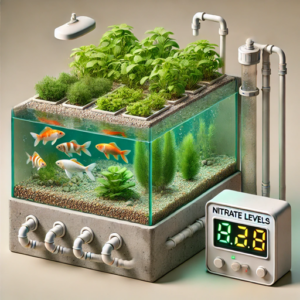
Aquaponics – How Much Nitrate Does an Aquaponics System Need? Hey there, fellow aquaponics enthusiast! If you’re like me, you’ve probably found yourself scratching your head over the nitrate levels in your system. It’s a common conundrum, and today, we’re going to dive deep into the world of nitrates in aquaponics. As someone who’s been tinkering with these systems for years, I’m excited to share my insights and help you understand just how much nitrate your aquaponics setup really needs.
Understanding Nitrates in Aquaponics
What are nitrates?
Let’s start with the basics. Nitrates are a form of nitrogen that plants absolutely love. In our aquaponics systems, they’re the end product of the nitrogen cycle – you know, that magical process where fish waste gets transformed into plant food. Pretty cool, right?
The role of nitrates in aquaponics
Nitrates are like the superheroes of our aquaponics world. They swoop in to feed our plants, helping them grow big and strong. Without enough nitrates, your plants might start looking a bit sad and yellow. On the flip side, too many nitrates can stress out your fish. It’s all about finding that sweet spot.
Optimal Nitrate Levels for Aquaponics
General nitrate range
Here’s the million-dollar question: how much nitrate does your system need? In my experience, most aquaponics systems thrive with nitrate levels between 5 and 150 parts per million (ppm). But don’t just take my word for it – let’s break it down a bit more.
Factors affecting nitrate requirements
Fish species
Different fish have different tolerances for nitrates. For instance, tilapia are pretty hardy and can handle higher levels, while trout prefer things on the lower end. I once had a system with goldfish that did great with nitrate levels around 40-60 ppm.
Plant types
Your plant choices also play a big role. Leafy greens like lettuce and spinach are nitrate-hungry and can handle higher levels. Fruiting plants like tomatoes and peppers prefer a bit less. In my system, I’ve found that a mix of plants does well with nitrate levels around 50-80 ppm.
System size
Bigger isn’t always better, but it does matter when it comes to nitrates. Larger systems tend to be more stable and can handle a broader range of nitrate levels. My first small system was a bit finicky, but as I scaled up, I found it easier to maintain consistent nitrate levels.
Measuring Nitrate Levels
Testing methods
Keeping tabs on your nitrate levels is crucial. I swear by liquid test kits for accuracy, but test strips can be handy for quick checks. There are also some nifty digital meters out there if you’re feeling fancy.
Frequency of testing
When I first started, I tested like a mad scientist—every day! Now, I’ve settled into a routine of testing once a week. But if you’re starting out or making changes to your system, more frequent testing is a good idea.
Managing Nitrate Levels
Increasing nitrate levels
If your nitrate levels are too low, don’t panic! You’ve got options. I’ve had success with adding more fish, increasing feeding, or even using organic nitrate supplements in a pinch. Just remember slow and steady wins the race – no need to shock your system.
Decreasing nitrate levels
On the flip side, if your nitrates are through the roof, it’s time to take action. Adding more plants is my go-to solution. I once turned a nitrate problem into a bumper crop of basil! Water changes can help, too, but remember, we’re trying to conserve water in aquaponics.
Common Challenges with Nitrate Management
Let’s be honest – managing nitrates isn’t always smooth sailing. I’ve had my fair share of algae blooms from high nitrates, and trust me, it’s not fun. Fluctuating pH levels can also throw your nitrates out of whack. The key is to stay vigilant and act quickly when you notice changes.
Benefits of Proper Nitrate Levels
Getting your nitrate levels just right is like hitting the aquaponics jackpot. Your plants will be lush and productive, your fish will be happy and healthy, and you’ll be basking in the glow of a well-balanced system. I can’t tell you how satisfying it is to see everything working in harmony.
Conclusion
So there you have it, folks – the nitty-gritty on nitrates in aquaponics. Remember, there’s no one-size-fits-all answer to how much nitrate your system needs. It’s all about finding the right balance for your specific setup. Keep testing, keep adjusting, and don’t be afraid to experiment. With a little patience and practice, you’ll be a nitrate-managing pro in no time!
FAQs
- Can I use tap water to top up my aquaponics system without affecting nitrate levels?
It depends on your local water quality. Some tap water contains nitrates, which could affect your system’s levels. I always recommend testing your tap water before adding it to your system. - How long does it take for nitrate levels to stabilize in a new aquaponics system?
In my experience, it usually takes about 4-6 weeks for nitrate levels to stabilize in a new system. However, this can vary depending on factors like system size and stocking density. - Are there any plants that can help reduce high nitrate levels quickly?
Yes! Fast-growing plants like duckweed and water lettuce are great at soaking up excess nitrates. I’ve used them as natural filters in my systems with great success. - Can high nitrate levels cause fish deaths in an aquaponics system?
While fish are generally more tolerant of nitrates than ammonia or nitrites, very high levels (above 250 ppm) can be stressful or even fatal to some species. It’s always best to keep levels in check. - Is it possible to have too little nitrate in an aquaponics system?
Absolutely! If nitrate levels drop below five ppm, your plants might start showing signs of nitrogen deficiency. I always aim to keep levels above this threshold for optimal plant growth.
Aquaponics – How Much Nitrate Does an Aquaponics System Need?


